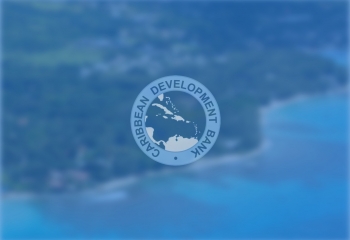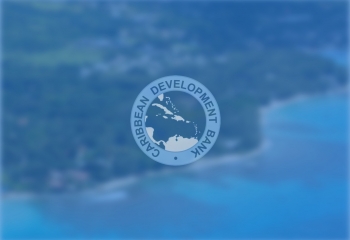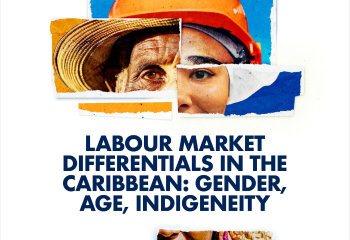The Future Is Now: Insights and Trends
Ladies and Gentlemen:
It certainly is a pleasure to gather with industry professionals and thought leaders from across Trinidad and Tobago for the 2023 Business Outlook Forum. On top of that, I also have the honour of delivering the Keynote Address at this important event, and I thank you – most sincerely – for this opportunity.
At this gathering, many questions will be asked and many insights and ideas shared about how we can achieve a more resilient future despite unfavourable global trends. At CDB, we link the desired future to the attainment of resilience in several dimensions. To this end, we posit that the Region needs a new approach to resilience building. It starts with a more holistic view of resilience – resilience in institutions, in the social and environment spheres, in production capacity, and in financing.
However, we cannot plan for these desired outcomes as if we have the luxury of time because we view “the future” as a timeframe on a distant horizon. The future is now. And my address this morning will focus on key insights and actions to germinate ideas to chart the way forward to get us to the desired end state.
As you shape a more positive business outlook, we know that both challenges and opportunities lie ahead, so first of all, allow me to make some observations on the global environment and economic outlook.
Global Environment and Economic Outlook
In our fast-paced environment, the global economy continues to grapple with several complex challenges. In its World Economic Outlook Report released in April 2023, the International Monetary Fund highlighted some major characteristics of a global economy including:
- Firstly, an aggressive monetary policy tightening that leads to a rapid rise in interest rates resulting in some cracks in the US and European financial systems and higher refinancing rates for Emerging Markets.
- Another is the deceleration yet still elevated rates of inflation, following multidecade highs in 2022 in many economies.
- And lastly, the uncertainty stemming from the lingering effects of the COVID-19 pandemic and the Russian invasion of Ukraine, which are both weighing on global supply chains.
Where does that leave us in countries like Trinidad and Tobago? The resulting prognosis is that global growth will fall from 3.4% in 2022 to 2.8% in 2023, before settling at 3.0% in 2024. Developments in the global economy will continue to influence the macroeconomic performance and economic development of our Region due to our trade interconnectedness, mainly via our tourism and financial services exports, and our commodities exports.
This is occurring against the backdrop of our strong economic recovery in 2022. Regional output grew by 11.0% (source: CDB, based on national statistical offices) although most Caribbean economies still recorded lower economic output than before the COVID-19 pandemic. Expectations are that growth will slow down to 6.4% in 2023 – with Trinidad and Tobago registering a strong performance in the energy sector – before reverting to pre-pandemic trends from next year.
As growth slows, the Region continues to contend with above-trend inflation which is eroding the real incomes of citizens, with vulnerable groups and low-income earners particularly hard hit. The higher cost of living compounds the human impacts of the multiple shocks since 2020 that have eroded long-held development gains, making the path to achieving the Sustainable Development Goals a more challenging one. Nevertheless, we press on!
We know that three things are certain:
- The global economic environment is laced with uncertainty and the Caribbean must adapt and innovate to ride the waves of uncertainty.
- The region must build resilience to external shocks – including from climate change - and strengthen institutional frameworks to improve governance, reporting, transparency, and accountability.
- Collaboration is of critical importance if we are to make tangible progress in areas such as climate change mitigation and adaptation; and food and energy security.
Here is one of the biggest concerns. Climate change presents a significant development challenge for small island developing states’ societies and economies around the globe. The impact of more intense tropical cyclones, storm surges, droughts, changing precipitation patterns, sea-level rise, and the effects of biodiversity loss will be increasingly affecting almost all sectors of our nations.
Against this backdrop, what does today’s theme “The Future Is Now: Insights and Trends” mean to CDB, to Trinidad and Tobago and to the wider Caribbean region?
For Trinidad and Tobago, this will require investments across a broad range of sectors to massively increase climate change mitigation and adaptation with a focus on creating an enabling environment for socially inclusive growth that includes increased measurement to help you to target outcomes and impacts better. I must stress inclusive growth here. Economic growth without equal opportunities and inclusion in activities that generate growth, such as financial inclusion, labour markets, access to education and skills, does not guarantee reduced poverty. Allow me to share some thoughts on the opportunities that these developments are creating for Trinidad and Tobago, a country that has traditionally built its economic development – to a large degree – on the energy sector. Opportunities that reinforce that the Future is now.
Opportunities for Energy Sector Transition and Growth
It is said that energy is the lifeblood of the modern economy and nowhere in the Region is this more true than in Trinidad and Tobago! You have been in the oil and gas industry since the 1940s, and it now contributes, on average, 30% to GDP. Even though I was a boy, I remember the significant discoveries of oil on the east and north coasts during the 1970s.
The sector has made the manufacturing industry competitive allowing for significant trade in goods within the CARICOM space.
While the abundance of hydrocarbon resources allowed for a build-out of one of the biggest industrial bases in the Caribbean, fewer inroads have been made transforming the energy sector and related industrial base in line with the global thrust for decarbonisation and transitioning towards sources of renewable energy. This transition has been slow. Renewable Energy’s share of electricity capacity in Trinidad and Tobago is only 0.2%, compared to a regional average of 12% and the global average of 40.2% (source: IRENA). To achieve the targets outlined in the CARICOM Sustainable Energy Road Map and Strategy – 47% by 2027 – Trinidad and Tobago’s Renewable Energy share should be closer to 28% as of today.
This is why we need some effective adjustments now, to change the future. And there are opportunities to make this happen. At present, one of the important requirements for achieving energy transition in Trinidad and Tobago is an improved regulatory framework. This will lead to clarified roles and responsibilities to facilitate the integration of renewables into the energy mix and provide incentives to diversify energy production towards renewables, thus triggering growth opportunities in your industry. Utility-scale renewable investments have the potential to support Trinidad and Tobago’s targets for reducing emissions. It can help the country relinquish some of the natural gas used in electricity production and direct that gas to the export market for increased country revenue, while simultaneously delivering cleaner power to the national grid. Importantly, in your Vision 2030: The National Development Strategy 2016-2030, Trinidad and Tobago has pledged its commitment to mainstreaming Energy Efficiency which is also geared at reducing emissions. At CDB, we believe that Energy Efficiency is a non-negotiable approach for countries to mitigate against climate change and lessen the burden that both governments and consumers face from rising energy costs.
While progress has been slow, I must commend recent efforts to accelerate this shift. It is clear that momentum is building and foundations are being laid to leverage your country’s competitive position in the energy sector to capitalise on emerging opportunities aligned with both the global climate agenda, as well as, national and regional energy security priorities. Notably, the advancements towards the development of utility-scale solar, and the devising of strategies and plans focused on other Renewable Energy sources, such as off-shore wind as an enabler for green hydrogen, are extremely encouraging.
These types of initiatives are well aligned with CDB’s own Energy Sector Strategy and Policy which articulates full support for clean energy transition while recognising that oil and gas will continue to play an important role for Caribbean countries including Trinidad and Tobago in the near to medium term. CDB is committed to working with Trinidad and Tobago and its other 18 Borrowing Member Countries (BMCs) and partners to accelerate the shift towards sustainable energy options as the current slow pace prolongs exposure to major risks. We are therefore focusing our support on catalysing actions to overcome known obstacles, scale-up sustainable energy investments, and increase resilience and energy security.
On this latter point, CDB has been working with key partners toward a Caribbean Regional Energy Integration and Decarbonization Assessment. It is clear that Trinidad and Tobago will continue to play an important leadership role in bolstering the Caribbean’s energy security, even while the region transitions towards low-carbon solutions. The future is now – I see more opportunities in the energy resilience building sphere. Another important factor driving the imperative to re-double our efforts to expedite the shift to Renewable Energy is the current and emerging threats to the region’s competitiveness from shifting global trade rules, particularly in relation to European trade, that increasingly require “green” products. For example, under the Carbon Border Adjustment Mechanism, CBAM, that will be implemented by the EU, beginning in October 2023 with a transitional phase coming into full effect in January 2026, selected carbon-intensive products imported into the EU will effectively be taxed based on their embedded Greenhouse Gas content. But there is an opportunity here as by reducing carbon intensity, you can improve the competitiveness of regional export. This will require action to accelerate the energy transition. In the case of Trinidad and Tobago, maintaining and enhancing the competitive standing of your petrochemicals industry including ammonia, urea, and methanol, key foreign exchange earners, is critical. As such, I must again commend the efforts made so far to devise strategies and plans for the development of a green hydrogen ecosystem, which can potentially transform Trinidad and Tobago’s industrial sector into a low- carbon economy.
Alongside energy security and climate change mitigation, there is now a general awareness that energy systems in the Caribbean need to be redesigned to increase resilience to the impacts of extreme natural events, which are exacerbated by climate change. Energy sector transition and the wider industrial sector transformation also present a welcome opportunity for establishing a more inclusive Trinidad and Tobago economic and social model by addressing existing gender gaps and equipping workers with low-carbon industry skills. And in all of this, we must remember youth employment. I am reminded of the words of one of the young ladies who participated in CDB’s Youth Fire which was part of the Annual Meeting of our Board of Governors this month. She said the lack of inclusivity still makes it hard for disabled persons to get and maintain jobs.
Perspectives for Trinidad and Tobago Economy
I close with some observations on the economic environment.
Climate change not only poses risks to Trinidad and Tobago’s energy sector assets but also to the broader economy and its future economic trajectory. According to a report from the Global Commission on Adaptation, every $1 invested in adaptation could yield up to $10 in net economic benefits, depending on the activity. Moreover, the social benefits of investing in climate change adaptation for vulnerable communities most susceptible to climate change that often lack access to basic services including utilities, infrastructure, financial services, health care, and social protection, will likely be higher.
According to a United Nations analysis, over the next five years, climate change is expected to cost businesses up to 120 billion United States dollars through supply chain disruptions alone. Conversely, transitioning to a more sustainable economy, including investments in Renewable Energy and sustainable infrastructure projects, could directly produce 26 trillion United States dollars in direct economic gains through 2030. Moreso, even with the loss of fossil fuel jobs, the 2020 Independent Expert Group on Climate Finance Report predicted that the Renewable Energy sector alone is expected to create as many as 18 million net jobs by 2030.
Governments such as Trinidad and Tobago must apply a holistic approach to adaptation and resilience- building and incorporate these into national budgeting and development planning across a very broad range of sectors. Your approach must be multifaceted to run the gamut from securing water resources to building resilience in the agricultural sector. From protecting coastal and marine resources to safeguarding terrestrial biodiversity. From strengthening the health sector to adapt to increasing and emerging diseases, to reducing weaknesses in infrastructure. And, from upgrading human settlements to improving disaster risk management
We note that while Trinidad and Tobago is encouraging the private sector to invest in climate change adaptation, it is also stimulating the private sector to collaborate on meeting its emission targets. Given the potentially transformational impact of green hydrogen in the decarbonisation of the economy, your recent launching of a roadmap for creating a green hydrogen economy and initiatives to kick-start the country’s first large photovoltaic project is extremely encouraging. This roadmap will help Trinidad and Tobago to maintain its leadership role in regional energy markets, help promote foreign direct investments, facilitate technology transfer, and ultimately boost job creation. For the first time, global investments in solar energy will surpass those in oil production in 2023. Trinidad and Tobago, in a very similar fashion to other small island development states of the Region, must emulate this global trend, albeit at an accelerated pace.
Concluding Remarks
Given the ever-present threat of climate change and its dire consequences on our economies and ecosystems, the future is now and the need to transition is urgent. CDB welcomes today’s discussions and exchange of ideas and insights as we explore how businesses must reposition to build more resilient and competitive economies that are inclusive and support environmental sustainability
The Bank is committed to allocating 25-30% of its own resources by 2024 to support inclusive climate change actions in BMCs. In addition to our resources, CDB has prioritised mobilising global resources to support sustainable energy initiatives.
Undoubtedly, Trinidad and Tobago will remain a key player in the regional energy ecosystem envisioned for the future. CDB is very well positioned and prepared to work with you on de-risking initial investment in this innovative sector! And businesses play a critical role in helping to navigate this space. I thank you for your attention.




